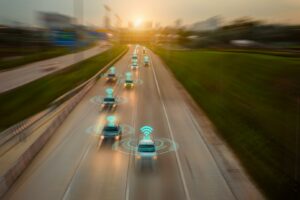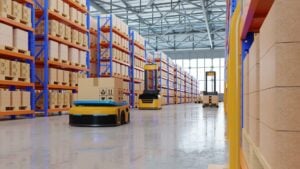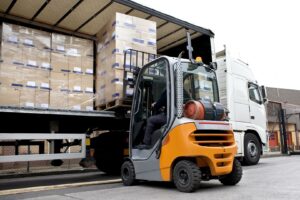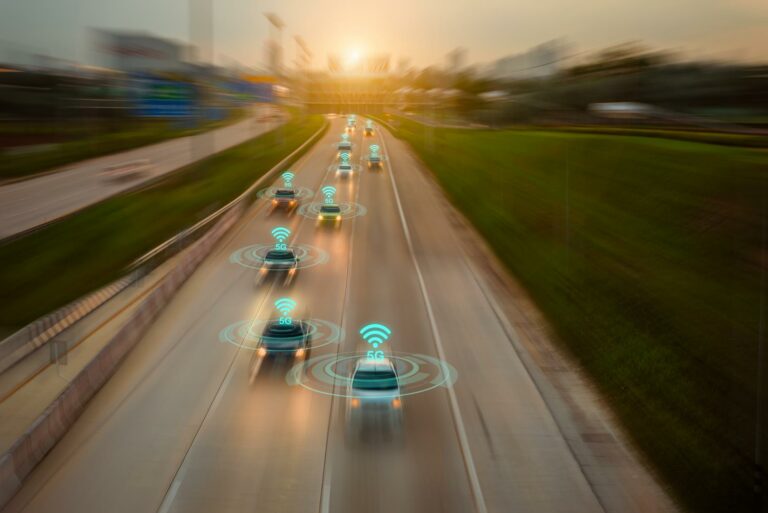In many places, the transport and logistics industry has reached a point where the focus on previous technologies and human actors is increasingly becoming a limiting factor instead of an important enabler of processes.

A (very recent) example is the situation in Great Britain. At the time of writing, the decision had just been made to use the military to deal with the fuel shortage that was rampant in the UK. While the bigger reason for the situation is Brexit, ultimately it all boils down to the fact that Britain’s hauliers have lost too many drivers (as a result). There is simply a lack of manpower to get enough tankers from refineries and depots to service stations.
Yet the situation shows not only how elementary the dependence on fossil fuels still is, but also how much the functioning of entire countries depends on a smoothly running transport and logistics industry – and on human actors.
Given this, the expectations towards 5G technology in our industry are truly gigantic. Not so much to replace humans, but rather because it can support human workers as effectively as is technically possible now and in the medium term.
The basics of 5G
5G is a fifth-generation mobile communications standard. However, it must be explained at this point that despite the name, a focus on mobile telephony and similar connectivity falls far short.
Unlike its predecessors, 5G was specifically designed to enable much greater and much broader connectivity. In other words, smartphones and similar devices will be just one player among many in 5G.
To understand how important 5G is also for our industry, it is necessary to compare the performance data with those of the 4G or LTE standard that has (still) prevailed up to now:
| 4G | 5G | |
| Data rate (Mbit/s) | 1000 | 10.000 |
| Latency (signal propagation time) (ms) | 50 bis 10 | </= 1 |
| Users per km² | 100.000 | 1.000.000 |
From a technical point of view, 5G therefore represents a dramatic evolutionary step compared to the predecessor standard.
However, with one condition: The higher performance requires a higher radio frequency. This means that the radio range for 5G is smaller. Accordingly, more distribution masts and similar installations are needed – the main reason why the technology requires such an extensive expansion phase along with investments on the part of the network operators.
5G and trucks
One of the most important reasons for the high expectations for 5G is that its three performance parameters are fundamental for assisted, intercommunicating mobility. For this reason, the impact on the entire transport and transport infrastructure sector is immense.

(stock.adobe.com © vladimircaribb)
Only 5G makes it practicable to support traffic under real-world conditions through mobile communications and the data transmitted in the process. Some important examples for the transport sector:
- Significantly more traffic routes monitored with cameras. This means that accidents and other congestion hazards can be transmitted to the responsible authorities in almost real time.
- Associated, more comprehensive electronic traffic signalling systems, which in turn achieve optimised traffic flow management.
- A vastly improved vehicle-to-vehicle communication, whereby numerous parameters can be transmitted, for example, location information, charging station occupancy, etc.
The most important effect, however, is that only 5G has sufficient performance to enable true real-time communication of even the largest data volumes. This makes the mobile radio standard the most important basic infrastructure that autonomous driving requires.
This relies on cameras, RADAR and similar sensor readings being transmitted between all nearby vehicles, even in the heaviest traffic.
However, true autonomous driving, where, for example, a driver is just a “better passenger”, is only a distant goal. Much closer in time is a massive support of the human driver by such data. At the lower autonomy levels, they provide for “semi-autonomous” driving, which massively reduces stress and accident risk.
Here, there is also the fact that networking has a greater range than any in-vehicle sensor could have. For example, RADAR or LIDAR sensors from different vehicles can be interconnected on any stretch of road and exchange their information with each other.
This means, for example, that a truck that has to brake behind a crest before the end of a traffic jam can already warn following colleagues, even though they are still kilometres away.
5G and the topic of warehouse robotics
If considerably more data can be transmitted in a significantly shorter time, then every application that needs a lot of data at high speed to function effectively will benefit.
Probably the most important application area for this in logistics is robotics. Regardless of whether these are devices that only support humans or those that act fully autonomously: Without 5G, these technologies would at least be significantly more limited in their performance – and more energy-hungry.

(stock.adobe.com © Vanitjan)
Last but not least, the safety factor in a warehouse environment dominated by both humans and robots must also be included here. With conventional (sensor) techniques, there is a real risk of accidents. Very similar to sensor-equipped but non-communicating vehicles because in this case the range of the sensor is limited to the detection range of the respective robot.
If, on the other hand, all the robots in a warehouse “talk” to each other in a 5G environment, then the safety for human employees is increased enormously. In addition, it is then possible for them to move naturally and not, for example, only use certain stripes.
5G and delivery drones
Drone technology has also made enormous leaps in development in recent years. What was initially little more than a version of the remote-controlled helicopter controlled by classic analogue radio has long since become one of the greatest beacons of hope, especially for B2C delivery logistics.
Only 5G enables such drones to operate truly autonomously. In addition, the constant flow of data in all directions means that this expensive device can be used as efficiently as possible. For example, a drone can constantly transmit its available residual energy in real time – extremely important because this can fluctuate greatly due to wind and other weather conditions.
Together with a customised AI, the drone can be re-planned (and autonomously) at any time how it should proceed after delivering its current load – back to recharge, a new package to a nearby customer or one to a customer further away.
5G and the supply chain
Up to now, we have mainly read about modern technologies that are only conceivable with the widespread availability of 5G. In fact, however, this mobile communications standard also enables a fascinating optimisation of existing procedures.

(stock.adobe.com © jdarius)
The best example of this is the entire supply chain of products and their transport containers. Only 5G makes it possible to transmit constant real-time information about location and other relevant factors from the warehouse shelf to the customer.
Even sea containers could be equipped with their own hubs, which in turn communicate with the ship’s systems and satellites, for example. Based on such precision, supply and production chains can be much better adapted to real conditions.
In this case, 5G alone can place the entire system of just-in-time production on a completely new foundation. One that no longer knows any imponderables because all real-time values are available at all times. This also closes the circle to another point:
5G and process management
In logistics, it often happens with previous transmission technologies that processing stations have to be changed over abruptly, or even cannot work at all, because delays become public suddenly and far too late.
Once again, 5G can bring a massive turnaround here, because there are no more imponderables. As soon as any point in the process chain reports via 5G that there is a delay, all the stations based on it can switch to another job that runs without disruption.
This means that 5G also removes the last hurdle to maximum efficiency between the assembly line and the warehouse: everything is known with crystal clarity at all times. This means that only what is currently both necessary and possible can be done at any time without delay.
In summary
The 5G mobile communications standard is currently the most important key technology imaginable for the transport and logistics industry. Everything that is currently feasible or even conceivable from a technical point of view is based on the gigantic data transmission capacity of this technology.
Ultimately, this also means that 5G is an “eye of the needle” or a “bottleneck”. And the better all those involved on the part of the network operators and politicians work together here, the faster this bottleneck will be overcome.
Admittedly, 5G is not a panacea for every problem. But it is one that can significantly mitigate the most pressing problems in our industry.









